Searching for "game based"
4 Benefits of Gamification in the Online Classroom
1. Combining Learning and Gaming Develops Additional Skills
2. Gamification Dwarfs the Fear of Failure
3. Game-Based Learning Provides Short-Term Rewards
4. Gamifying the Learning Experience Promotes Collaboration and Healthy Competition
++++++++++++++
more on gamification in this IMS blog
https://blog.stcloudstate.edu/ims?s=gamification
https://www.edsurge.com/news/2021-04-06-how-interactive-3d-is-transforming-the-way-we-learn-and-work
EdSurge recently talked with Linda Sellheim, Education Lead at Epic Games
Interactive 3D is the ability to interact with the digital world the same way you do with the real world. These experiences can take many forms, from dynamic web-based content to immersive VR, AR or MR experiences. You know those realistic simulations of storms you see on the Weather Channel? That’s interactive 3D.
Burning Glass to identify the types of 3D skills needed in the workplace. They found that jobs requiring real-time 3D skills are growing 601 percent faster than the job market overall, and pay 57 percent above the average advertised salary
Imagine building a history museum in Unreal Engine and having students populate the displays. That’s what some classes are doing.
this blog post that includes the new Creator’s Field Guide to Emerging Careers in Interactive 3D.
all educators to check out resources such as Unreal Engine’s Secondary Education Lesson Plans and Games For Change.
+++++++++++++++
more on 3D in this IMS blog
https://blog.stcloudstate.edu/ims?s=3D
Home
What the Deck is an exploratory, card-based game that aims to introduce students, faculty and staff of all ages and backgrounds to a wide variety of situations in which established and emerging technologies impact society.
Nreal (Finally) Expanding to the US This Spring
https://arpost.co/2021/02/22/nreal-finally-expanding-to-the-us-this-spring/amp/
The China-based company announced the Nreal Light smart glasses in May of 2019. The surprisingly sleek and powerful consumer glasses with a $500 price tag
They’ve had huge success in China, but China is a pretty unique market. In late 2019, they expanded to Korea
the company is partnered with Deutsche Telekom and LG Uplus in Germany and Korea respectively, so it’s not too far a stretch to wager that the US branches of those carriers (T-Mobile and LG Electronics) will form at least part of their US distribution channels.
Finch Technologies makes body-tracking wearable devices to serve as controllers for XR applications and experiences including the recently announced FinchRing (this is the promised cherry on top).
The finger-worn hand tracker is designed to enable convenient and discreet 6-degree-of-freedom controls.
- Tagesschau 2025 – an application based on a German news program that will present, among other features, holographic weather forecasts;
- A virtual basketball game called DunkaAR;
- An MR mode for the in-browser MMORPG Dragon Awaken;
- An augmented reality football streaming application from Magenta Sport.
++++++++++++++
more on immersive in this IMS blog
https://blog.stcloudstate.edu/ims?s=immersive
more on Nreal in this IMS blog
https://blog.stcloudstate.edu/ims?s=nreal+smartglass
CALL FOR PAPERS AND PROPOSALS
iLRN 2021: 7th International Conference of the Immersive Learning Research Network
May 17 to June 10, 2021, on iLRN Virtual Campus, powered by Virbela
… and across the Metaverse!
Technically co-sponsored by the IEEE Education Society,
with proceedings to be submitted for inclusion in IEEE Xplore(r)
Conference theme: “TRANSCEND: Accelerating Learner Engagement in XR across Time, Place, and Imagination”
+++++++++++++++++++++++++++++++++++++++++++++++++++++++++++++
The 7th International Conference of the Immersive Learning Research Network (iLRN 2021) will be an innovative and interactive virtual gathering for a strengthening global network of researchers and practitioners collaborating to develop the scientific, technical, and applied potential of immersive learning. It is the premier scholarly event focusing on advances in the use of virtual reality (VR), augmented reality (AR), mixed reality (MR), and other extended reality (XR) technologies to support learners across the full span of learning–from K-12 through higher education to work-based, informal, and lifelong learning contexts.
Following the success of iLRN 2020, our first fully online and in-VR conference, this year’s conference will once again be based on the iLRN Virtual Campus, powered by VirBELA, but with a range of activities taking place on various other XR simulation, gaming, and other platforms. Scholars and professionals working from informal and formal education settings as well as those representing diverse industry sectors are invited to participate in the conference, where they may share their research findings, experiences, and insights; network and establish partnerships to envision and shape the future of XR and immersive technologies for learning; and contribute to the emerging scholarly knowledge base on how these technologies can be used to create experiences that educate, engage, and excite learners.
Note: Last year’s iLRN conference drew over 3,600 attendees from across the globe, making the scheduling of sessions a challenge. This year’s conference activities will be spread over a four-week period so as to give attendees more opportunities to participate at times that are conducive to their local time zones.
##### TOPIC AREAS #####
XR and immersive learning in/for:
Serious Games • 3D Collaboration • eSports • AI & Machine Learning • Robotics • Digital Twins • Embodied Pedagogical Agents • Medical & Healthcare Education • Workforce & Industry • Cultural Heritage • Language Learning • K-12 STEM • Higher Ed & Workforce STEM • Museums & Libraries • Informal Learning • Community & Civic Engagement • Special Education • Geosciences • Data Visualization and Analytics • Assessment & Evaluation
##### SUBMISSION STREAMS & CATEGORIES #####
ACADEMIC STREAM (Refereed paper published in proceedings):
– Full (6-8 pages) paper for oral presentation
– Short paper (4-5 pages) for oral presentation
– Work-in-progress paper (2-3 pages) for poster presentation
– Doctoral colloquium paper (2-3 pages)
PRACTITIONER STREAM (Refereed paper published in proceedings):
– Oral presentation
– Poster presentation
– Guided virtual adventures
– Immersive learning project showcase
NONTRADITIONAL SESSION STREAM (1-2 page extended abstract describing session published in proceedings):
– Workshop
– Special session
– Panel session
##### SESSION TYPES & SESSION FORMATS #####
– Oral Presentation: Pre-recorded video + 60-minute live in-world discussion with
others presenting on similar/related topics (groupings of presenters into sessions determined by Program Committee)
– Poster Presentation: Live poster session in 3D virtual exhibition hall; pre-recorded video optional
– Doctoral Colloquium: 60-minute live in-world discussion with other doctoral researchers; pre-recorded video optional
– Guided Virtual Adventures: 60-minute small-group guided tours of to various social and collaborative XR/immersive environments and platforms
– Immersive Learning Project Showcase: WebXR space to assemble a collection of virtual artifacts, accessible to attendees throughout the conference
– Workshop: 1- or 2-hour live hands-on session
– Special Session: 30- or 60-minute live interactive session held in world; may optionally be linked to one or more papers
– Panel Session: 60-minute live in-world discussion with a self-formed group of 3-5 panelists (including a lead panelist who serves as a moderator)
Please see the conference website for templates and guidelines.
##### PROGRAM TRACKS #####
Papers and proposals may be submitted to one of 10 program tracks, the first nine of which correspond to the iLRN Houses of application, and the tenth of which is intended for papers making knowledge contributions to the learning sciences, computer science, and/or game studies that are not linked to any particular application area:
Track 1. Assessment and Evaluation (A&E)
Track 2. Early Childhood Development & Learning (ECDL)
Track 3. Galleries, Libraries, Archives, & Museums (GLAM)
Track 4. Inclusion, Diversity, Equity, Access, & Social Justice (IDEAS)
Track 5. K-12 STEM Education
Track 6. Language, Culture, & Heritage (LCH)
Track 7. Medical & Healthcare Education (MHE)
Track 8. Nature & Environmental Sciences (NES)
Track 9. Workforce Development & Industry Training (WDIT)
Track 10. Basic Research and Theory in Immersive Learning (not linked to any particular application area)
##### PAPER/PROPOSAL SUBMISSION & REVIEW #####
Papers for the Academic Stream and extended-abstract proposals for the Nontraditional Session Stream must be prepared in standard IEEE double-column US Letter format using Microsoft Word or LaTeX, and will be accepted only via the online submission system, accessible via the conference website (from which guidelines and templates are also available).
Proposals for the Practitioner Stream are to be submitted via an online form, also accessible from the conference website.
A blind peer-review process will be used to evaluate all submissions.
##### IMPORTANT DATES #####
– Main round submission deadline – all submission types welcome: 2021-01-15
– Notification of review outcomes from main submission round: 2021-04-01
– Late round submission deadline – Work-in-progress papers, practitioner presentations, and nontraditional sessions only: 2021-04-08
– Camera-ready papers for proceedings due – Full and short papers: 2021-04-15
– Presenter registration deadline – Full and short papers (also deadline for early-bird registration rates): 2021-04-15
– Notification of review outcomes from late submission round: 2021-04-19
– Camera-ready work-in-progress papers and nontraditional session extended abstracts for proceedings due; final practitioner abstracts for conference program due: 2021-05-03
– Presenter registration deadline – Work-in-progress papers, practitioner presentations, and nontraditional sessions: 2021-05-03
– Deadline for uploading presentation materials (videos, slides for oral presentations, posters for poster presentations): 2021-05-10
– Conference opening: 2021-05-17
– Conference closing: 2021-06-10
*Full and short papers can only be submitted in the main round.
##### PUBLICATION & INDEXING #####
All accepted and registered papers in the Academic Stream that are presented at iLRN 2021 and all extended abstracts describing the Nontraditional Sessions presented at the conference will be published in the conference proceedings and submitted to the IEEE Xplore(r) digital library.
Content loaded into Xplore is made available by IEEE to its abstracting and indexing partners, including Elsevier (Scopus, EiCompendex), Clarivate Analytics (CPCI–part of Web of Science) and others, for potential inclusion in their respective databases. In addition, the authors of selected papers may be invited to submit revised and expanded versions of their papers for possible publication in the IEEE Transactions on Learning Technologies (2019 JCR Impact Factor: 2.714), the Journal of Universal Computer Science (2019 JCR Impact Factor: 0.91), or another Scopus and/or Web of Science-indexed journal, subject to the relevant journal’s regular editorial and peer-review policies and procedures.
##### CONTACT #####
More on Virbela in this IMS blog
https://blog.stcloudstate.edu/ims?s=virbela
Information Overload Helps Fake News Spread, and Social Media Knows It
Understanding how algorithm manipulators exploit our cognitive vulnerabilities empowers us to fight back
https://www.scientificamerican.com/article/information-overload-helps-fake-news-spread-and-social-media-knows-it/
a minefield of cognitive biases.
People who behaved in accordance with them—for example, by staying away from the overgrown pond bank where someone said there was a viper—were more likely to survive than those who did not.
Compounding the problem is the proliferation of online information. Viewing and producing blogs, videos, tweets and other units of information called memes has become so cheap and easy that the information marketplace is inundated. My note: folksonomy in its worst.
At the University of Warwick in England and at Indiana University Bloomington’s Observatory on Social Media (OSoMe, pronounced “awesome”), our teams are using cognitive experiments, simulations, data mining and artificial intelligence to comprehend the cognitive vulnerabilities of social media users.
developing analytical and machine-learning aids to fight social media manipulation.
As Nobel Prize–winning economist and psychologist Herbert A. Simon noted, “What information consumes is rather obvious: it consumes the attention of its recipients.”
attention economy
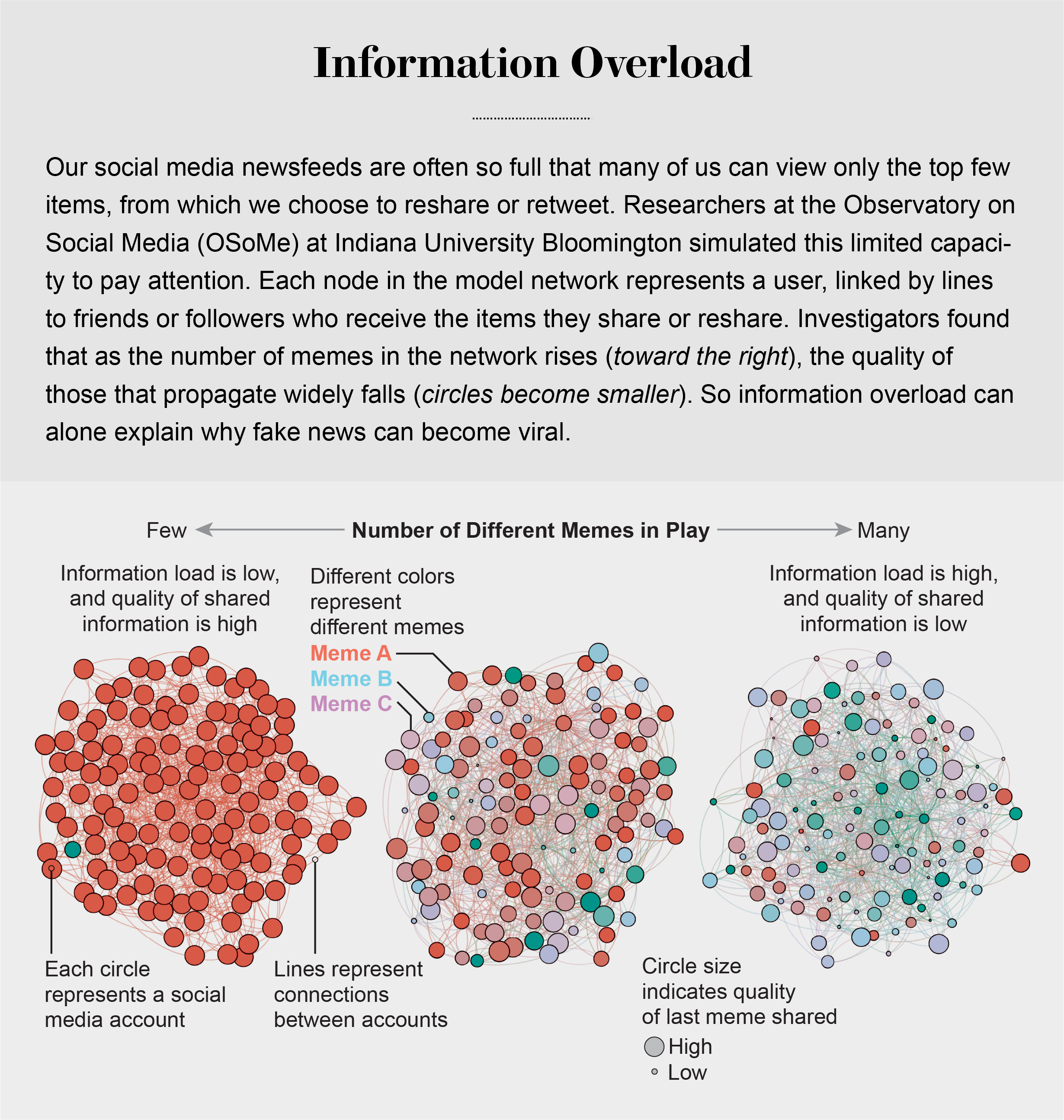
Our models revealed that even when we want to see and share high-quality information, our inability to view everything in our news feeds inevitably leads us to share things that are partly or completely untrue.
Frederic Bartlett
Cognitive biases greatly worsen the problem.
We now know that our minds do this all the time: they adjust our understanding of new information so that it fits in with what we already know. One consequence of this so-called confirmation bias is that people often seek out, recall and understand information that best confirms what they already believe.
This tendency is extremely difficult to correct.
Making matters worse, search engines and social media platforms provide personalized recommendations based on the vast amounts of data they have about users’ past preferences.
pollution by bots
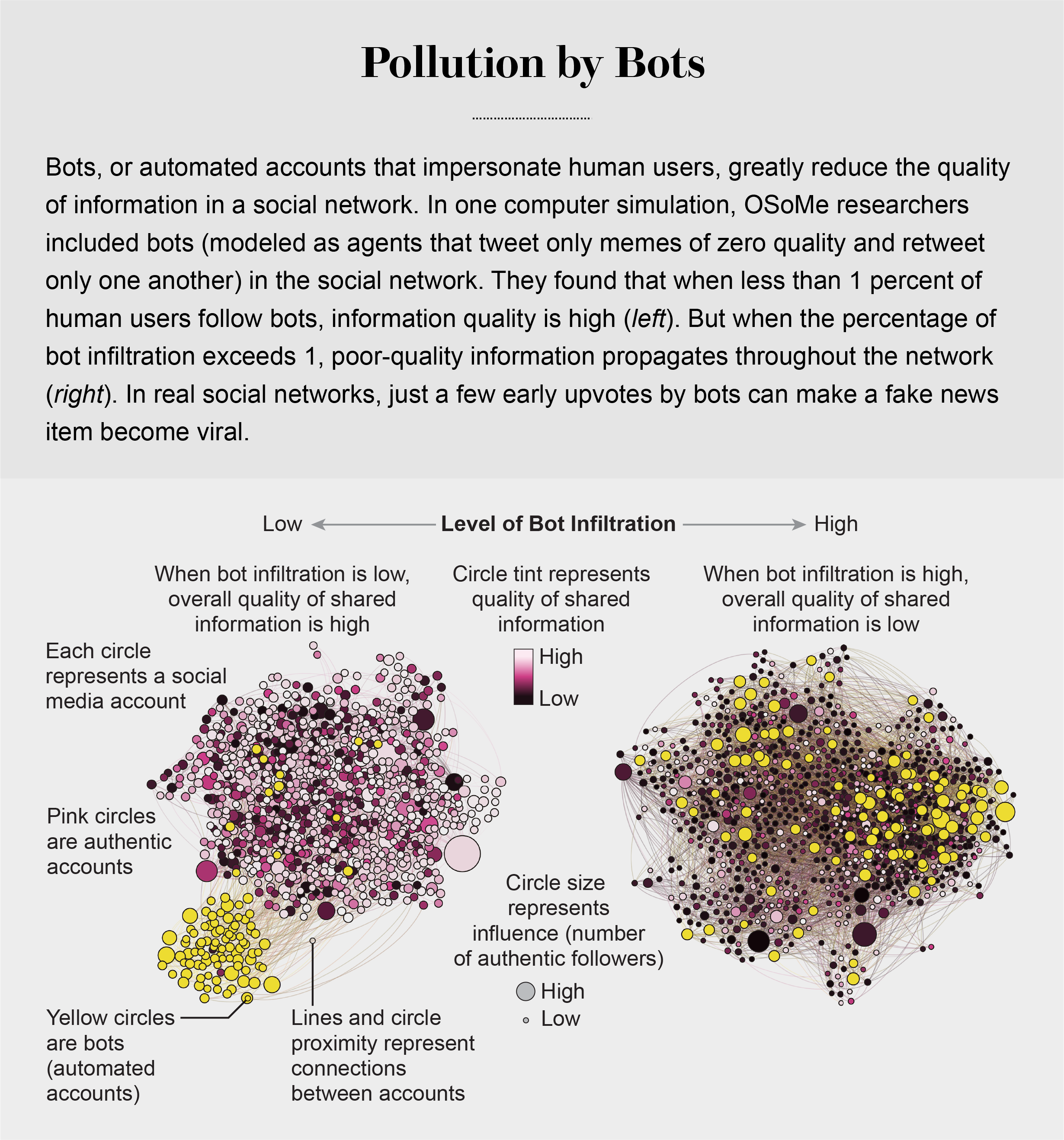
Social Herding
social groups create a pressure toward conformity so powerful that it can overcome individual preferences, and by amplifying random early differences, it can cause segregated groups to diverge to extremes.
Social media follows a similar dynamic. We confuse popularity with quality and end up copying the behavior we observe.
information is transmitted via “complex contagion”: when we are repeatedly exposed to an idea, typically from many sources, we are more likely to adopt and reshare it.
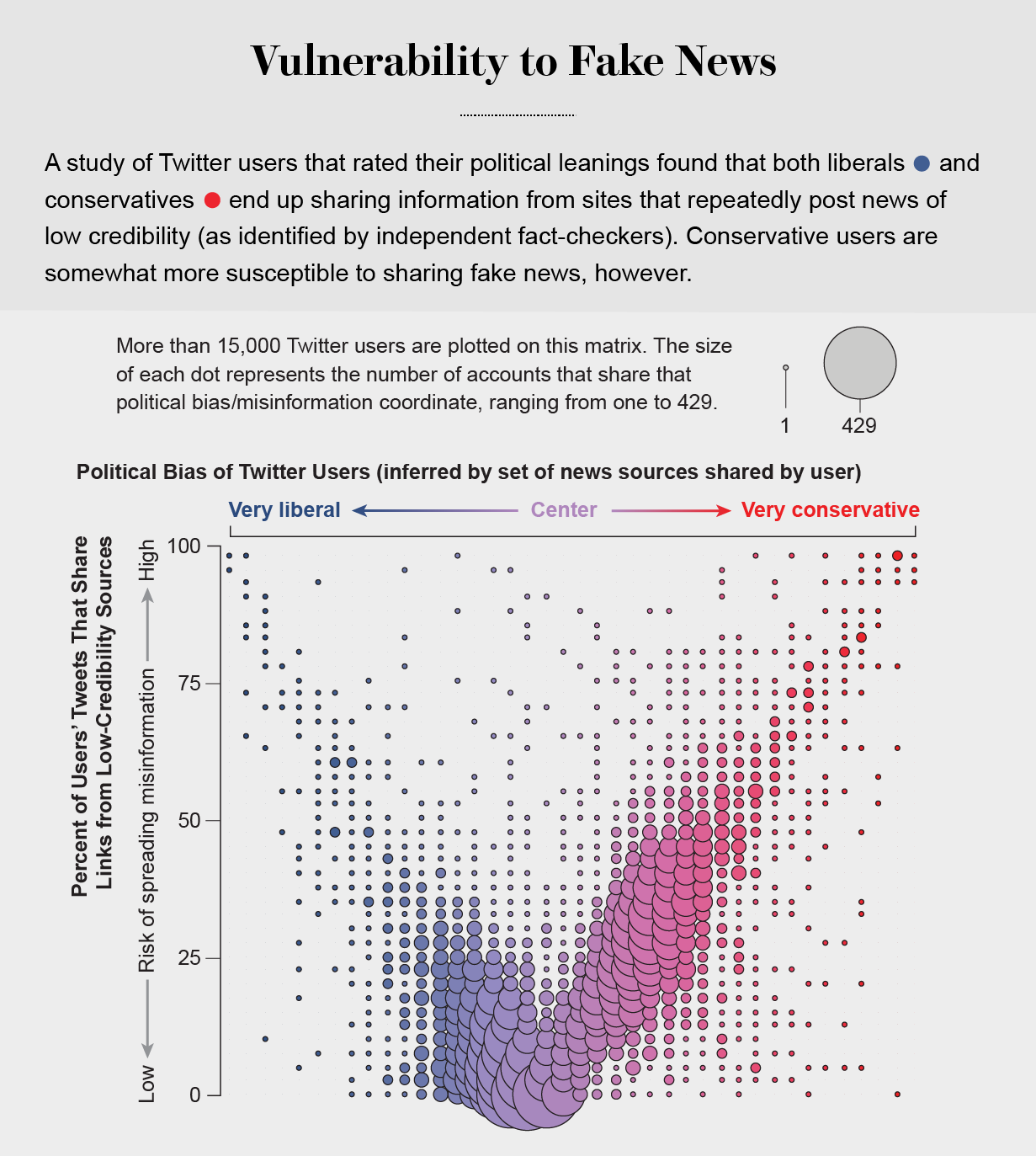
In addition to showing us items that conform with our views, social media platforms such as Facebook, Twitter, YouTube and Instagram place popular content at the top of our screens and show us how many people have liked and shared something. Few of us realize that these cues do not provide independent assessments of quality.
programmers who design the algorithms for ranking memes on social media assume that the “wisdom of crowds” will quickly identify high-quality items; they use popularity as a proxy for quality. My note: again, ill-conceived folksonomy.
Echo Chambers
the political echo chambers on Twitter are so extreme that individual users’ political leanings can be predicted with high accuracy: you have the same opinions as the majority of your connections. This chambered structure efficiently spreads information within a community while insulating that community from other groups.
socially shared information not only bolsters our biases but also becomes more resilient to correction.
machine-learning algorithms to detect social bots. One of these, Botometer, is a public tool that extracts 1,200 features from a given Twitter account to characterize its profile, friends, social network structure, temporal activity patterns, language and other features. The program compares these characteristics with those of tens of thousands of previously identified bots to give the Twitter account a score for its likely use of automation.
Some manipulators play both sides of a divide through separate fake news sites and bots, driving political polarization or monetization by ads.
recently uncovered a network of inauthentic accounts on Twitter that were all coordinated by the same entity. Some pretended to be pro-Trump supporters of the Make America Great Again campaign, whereas others posed as Trump “resisters”; all asked for political donations.
a mobile app called Fakey that helps users learn how to spot misinformation. The game simulates a social media news feed, showing actual articles from low- and high-credibility sources. Users must decide what they can or should not share and what to fact-check. Analysis of data from Fakey confirms the prevalence of online social herding: users are more likely to share low-credibility articles when they believe that many other people have shared them.
Hoaxy, shows how any extant meme spreads through Twitter. In this visualization, nodes represent actual Twitter accounts, and links depict how retweets, quotes, mentions and replies propagate the meme from account to account.
Free communication is not free. By decreasing the cost of information, we have decreased its value and invited its adulteration.
Gamification Network: Exploring Gamification through the Octalysis Lens
Mary Nunaley
Karl Kapp The Gamification of Learning and Instruction
Kevin Werbach, Dan Hunter How Game Thinking Can Revolutionize Your Business
Yu-Kai Chou gamification design. Octalysis. https://www.gish.com/
8 core drives:
Meaning
Accomplishment
Empowerment
Ownership
Social Influence. social media, instagram influencers
Scarcity: scarcity with homework deadlines, coupons at the store
Unpredictability and curiosity. scavenger hunt in courses. careful when teaching.
Avoidance
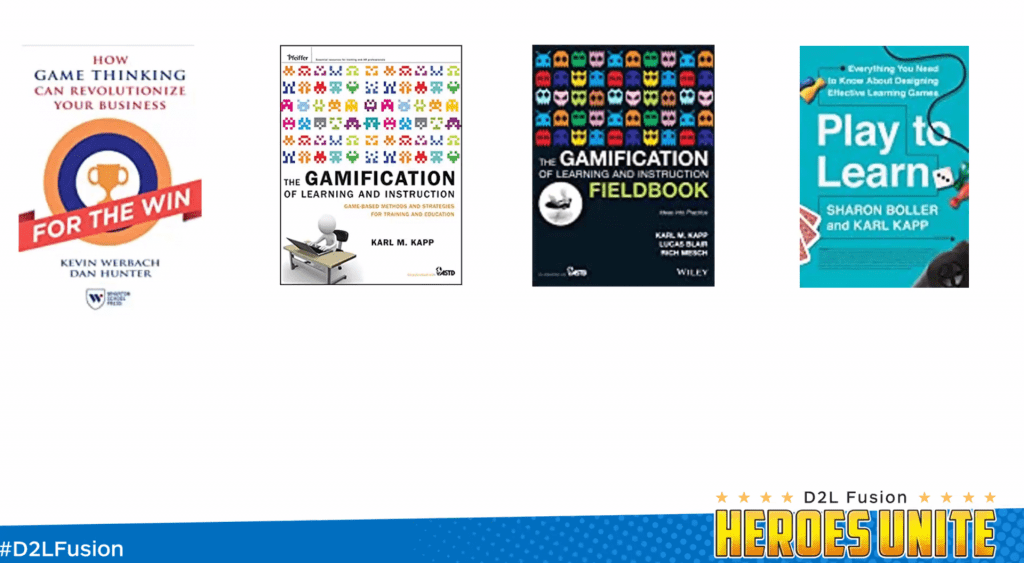
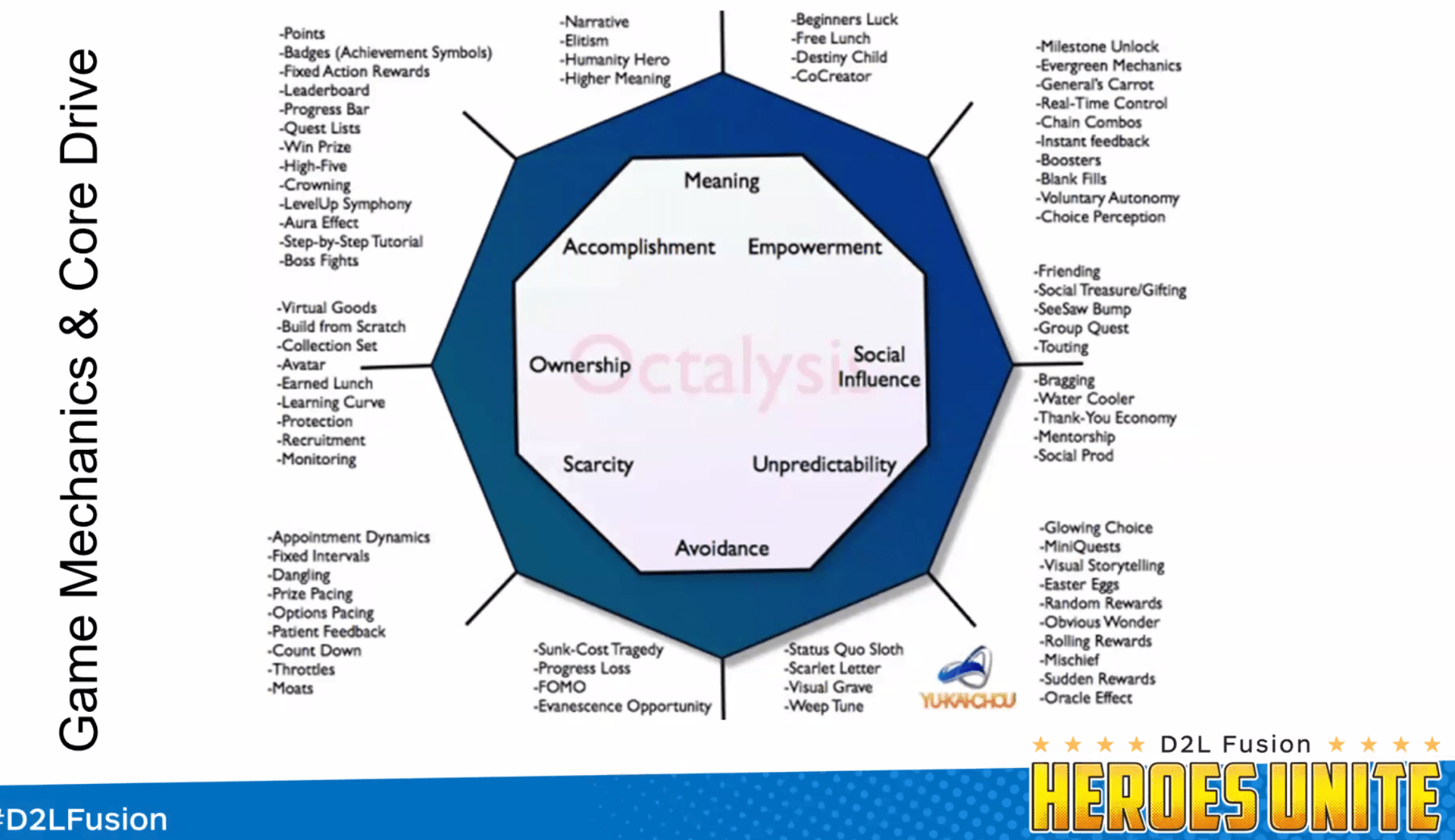
Octalysis – the complete Gamification framework
Webinars
motivation
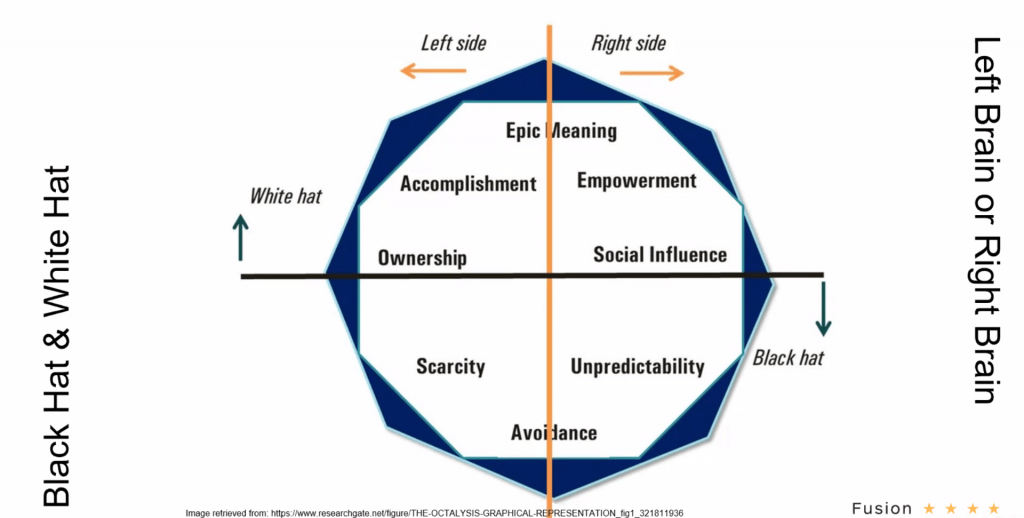
+++++++++++++++
https://yukaichou.com/octalysis-tool/
+++++++++++++++
https://island.octalysisprime.com/
+++++++++++++
https://yukaichou.com/
+++++++++++++
Home
++++++++++++++
++++++++++++
more on gamification in this IMS blog
https://blog.stcloudstate.edu/ims?s=gamification
https://www.techopedia.com/definition/25604/virtual-world
A virtual world is a computer-based online community environment that is designed and shared by individuals so that they can interact in a custom-built, simulated world. Users interact with each other in this simulated world using text-based, two-dimensional or three-dimensional graphical models called avatars. Avatars are graphically rendered using computer graphics imaging (CGI) or any other rendering technology. Individuals control their avatars using input devices like the keyboard, mouse and other specially designed command and simulation gadgets. Today’s virtual worlds are purpose-built for entertainment, social, ed
Girvan, C. (2018). What is a virtual world? Definition and classification.
Educational Technology Research and Development,
66(5), 1087–1100.
https://doi.org/10.1007/s11423-018-9577-y“definitions of virtual worlds lack an essential conceptualisation of what a virtual world is. The propensity towards a techno-centric definition has its advantages as it allows for a myriad of user experiences, however it results in confusion between technologies with similar technical features, most likely because a virtual world, much like a smart phone, relies on a combination of different technologies.
Shared, simulated spaces which are inhabited and shaped by their inhabitants who are represented as avatars. These avatars mediate our experience of this space as we move, interact with objects and interact with others, with whom we construct a shared understanding of the world at that time.”
https://www.yourdictionary.com/virtual-world
A 3D computer environment in which users are represented on screen as themselves or as made-up characters and interact in real time with other users. Massively multiuser online games (MMOGs) and worlds such as Second Life are examples. See MMOG, MMORPG, Second Life and metaverse.
++++++++++
more on virtual worlds in this IMS blog
https://blog.stcloudstate.edu/ims?s=virtual+worlds
This is an excerpt from my 2018 book chapter: https://www.academia.edu/41628237/Chapter_12_VR_AR_and_Video_360_A_Case_Study_Towards_New_Realities_in_Education_by_Plamen_Miltenoff
Among a myriad of other definitions, Noor (2016) describes Virtual Reality (VR) as “a computer generated environment that can simulate physical presence in places in the real world or imagined worlds. The user wears a headset and through specialized software and sensors is immersed in 360-degree views of simulated worlds” (p. 34).
Noor, Ahmed. 2016. “The Hololens Revolution.” Mechanical Engineering 138(10):30-35.
Weiss and colleagues wrote that “Virtual reality typically refers to the use of interactive simulations created with computer hardware and software to present users with opportunities to engage in environments that appear to be and feel similar to real-world objects and events”
Weiss, P. L., Rand, D., Katz, N., & Kizony, R. (2004). Video capture virtual reality as a flexible and effective rehabilitation tool. Journal of NeuroEngineering and Rehabilitation, 1(1), 12. https://doi.org/10.1186/1743-0003-1-12
Henderson defined virtual reality as a “computer based, interactive, multisensory environment that occurs in real time”
Rubin, 2018, p. 28. Virtual reality is an 1. artificial environment that’s 2. immersive enough to convince you that you are 3. actually inside it.
”artificialenvironment ” could mean just about anything. The photograph is an artificial environment of video game is an artificial environment a Pixar movie is an artificial environment the only thing that matters is that it’s not where are you physically are. p. 46 “VR is potentially going to become a direct interface to the subconscious”
- p. 225 Virtual reality: the illusion of an all-enveloping artificial world, created by wearing an opaque display in front of your eyes.
From: https://blog.stcloudstate.edu/ims/2018/11/07/can-xr-help-students-learn/ :
p. 10 “there is not universal agreement on the definitions of these terms or on the scope of these technologies. Also, all of these technologies currently exist in an active marketplace and, as in many rapidly changing markets, there is a tendency for companies to invent neologisms around 3D technology.” p. 11 Virtual reality means that the wearer is completely immersed in a computer simulation.
from: https://blog.stcloudstate.edu/ims/2018/11/07/can-xr-help-students-learn/
There is no necessary distinction between AR and VR; indeed, much research
on the subject is based on a conception of a “virtuality continuum” from entirely
real to entirely virtual, where AR lies somewhere between those ends of the
spectrum. Paul Milgram and Fumio Kishino, “A Taxonomy of Mixed Reality Visual Displays,” IEICE Transactions on Information Systems, vol. E77-D, no. 12 (1994); Steve Mann, “Through the Glass, Lightly,” IEEE Technology and Society Magazine 31, no. 3 (2012): 10–14.
++++++++++++++++++++++
Among a myriad of other definitions, Noor (2016) describes Virtual Reality (VR) as “a computer generated environment that can simulate physical presence in places in the real world or imagined worlds. The user wears a headset and through specialized software and sensors is immersed in 360-degree views of simulated worlds” (p. 34). Weiss and colleagues wrote that “Virtual reality typically refers to the use of interactive simulations created with computer hardware and software to present users with opportunities to engage in environments that appear to be and feel similar to real-world objects and events.”
Rubin takes a rather broad approach ascribing to VR: 1. artificial environment that’s 2. immersive enough to convince you that you are 3. actually inside it. (p. 28) and further asserts “VR is potentially going to become a direct interface to the subconscious” (p. 46).
Most importantly, as Pomeranz (2018) asserts, “there is not universal agreement on the definitions of these terms or on the scope of these technologies. Also, all of these technologies currently exist in an active marketplace and, as in many rapidly changing markets, there is a tendency for companies to invent neologisms.” (p. 10)
Noor, Ahmed. 2016. “The Hololens Revolution.” Mechanical Engineering 138(10):30-35.
Pomerantz, J. (2018). Learning in Three Dimensions: Report on the EDUCAUSE/HP Campus of the Future Project (Louisville, CO; ECAR Research Report, p. 57). https://library.educause.edu/~/media/files/library/2018/8/ers1805.pdf
Rubin, P. (2018). Future Presence: How Virtual Reality Is Changing Human Connection, Intimacy, and the Limits of Ordinary Life (Illustrated edition). HarperOne.
Weiss, P. L., Rand, D., Katz, N., & Kizony, R. (2004). Video capture virtual reality as a flexible and effective rehabilitation tool. Journal of NeuroEngineering and Rehabilitation, 1(1), 12. https://doi.org/10.1186/1743-0003-1-12
Emerging Trends and Impacts of the Internet of Things in Libraries
https://www.igi-global.com/gateway/book/244559
Chapters:
Holland, B. (2020). Emerging Technology and Today’s Libraries. In Holland, B. (Eds.), Emerging Trends and Impacts of the Internet of Things in Libraries (pp. 1-33). IGI Global. http://doi:10.4018/978-1-7998-4742-7.ch001
The purpose of this chapter is to examine emerging technology and today’s libraries. New technology stands out first and foremost given that they will end up revolutionizing every industry in an age where digital transformation plays a major role. Major trends will define technological disruption. The next-gen of communication, core computing, and integration technologies will adopt new architectures. Major technological, economic, and environmental changes have generated interest in smart cities. Sensing technologies have made IoT possible, but also provide the data required for AI algorithms and models, often in real-time, to make intelligent business and operational decisions. Smart cities consume different types of electronic internet of things (IoT) sensors to collect data and then use these data to manage assets and resources efficiently. This includes data collected from citizens, devices, and assets that are processed and analyzed to monitor and manage, schools, libraries, hospitals, and other community services.
Makori, E. O. (2020). Blockchain Applications and Trends That Promote Information Management. In Holland, B. (Eds.),
Emerging Trends and Impacts of the Internet of Things in Libraries (pp. 34-51). IGI Global.
http://doi:10.4018/978-1-7998-4742-7.ch002Blockchain revolutionary paradigm is the new and emerging digital innovation that organizations have no choice but to embrace and implement in order to sustain and manage service delivery to the customers. From disruptive to sustaining perspective, blockchain practices have transformed the information management environment with innovative products and services. Blockchain-based applications and innovations provide information management professionals and practitioners with robust and secure opportunities to transform corporate affairs and social responsibilities of organizations through accountability, integrity, and transparency; information governance; data and information security; as well as digital internet of things.
Hahn, J. (2020). Student Engagement and Smart Spaces: Library Browsing and Internet of Things Technology. In Holland, B. (Eds.),
Emerging Trends and Impacts of the Internet of Things in Libraries (pp. 52-70). IGI Global.
http://doi:10.4018/978-1-7998-4742-7.ch003The purpose of this chapter is to provide evidence-based findings on student engagement within smart library spaces. The focus of smart libraries includes spaces that are enhanced with the internet of things (IoT) infrastructure and library collection maps accessed through a library-designed mobile application. The analysis herein explored IoT-based browsing within an undergraduate library collection. The open stacks and mobile infrastructure provided several years (2016-2019) of user-generated smart building data on browsing and selecting items in open stacks. The methods of analysis used in this chapter include transactional analysis and data visualization of IoT infrastructure logs. By analyzing server logs from the computing infrastructure that powers the IoT services, it is possible to infer in greater detail than heretofore possible the specifics of the way library collections are a target of undergraduate student engagement.
Treskon, M. (2020). Providing an Environment for Authentic Learning Experiences. In Holland, B. (Eds.),
Emerging Trends and Impacts of the Internet of Things in Libraries (pp. 71-86). IGI Global.
http://doi:10.4018/978-1-7998-4742-7.ch004The Loyola Notre Dame Library provides authentic learning environments for undergraduate students by serving as “client” for senior capstone projects. Through the creative application of IoT technologies such as Arduinos and Raspberry Pis in a library setting, the students gain valuable experience working through software design methodology and create software in response to a real-world challenge. Although these proof-of-concept projects could be implemented, the library is primarily interested in furthering the research, teaching, and learning missions of the two universities it supports. Whether the library gets a product that is worth implementing is not a requirement; it is a “bonus.”
Rashid, M., Nazeer, I., Gupta, S. K., & Khanam, Z. (2020). Internet of Things: Architecture, Challenges, and Future Directions. In Holland, B. (Ed.),
Emerging Trends and Impacts of the Internet of Things in Libraries (pp. 87-104). IGI Global.
http://doi:10.4018/978-1-7998-4742-7.ch005The internet of things (IoT) is a computing paradigm that has changed our daily livelihood and functioning. IoT focuses on the interconnection of all the sensor-based devices like smart meters, coffee machines, cell phones, etc., enabling these devices to exchange data with each other during human interactions. With easy connectivity among humans and devices, speed of data generation is getting multi-fold, increasing exponentially in volume, and is getting more complex in nature. In this chapter, the authors will outline the architecture of IoT for handling various issues and challenges in real-world problems and will cover various areas where usage of IoT is done in real applications. The authors believe that this chapter will act as a guide for researchers in IoT to create a technical revolution for future generations.
Martin, L. (2020). Cloud Computing, Smart Technology, and Library Automation. In Holland, B. (Eds.),
Emerging Trends and Impacts of the Internet of Things in Libraries (pp. 105-123). IGI Global.
http://doi:10.4018/978-1-7998-4742-7.ch006As technology continues to change, the landscape of the work of librarians and libraries continue to adapt and adopt innovations that support their services. Technology also continues to be an essential tool for dissemination, retrieving, storing, and accessing the resources and information. Cloud computing is an essential component employed to carry out these tasks. The concept of cloud computing has long been a tool utilized in libraries. Many libraries use OCLC to catalog and manage resources and share resources, WorldCat, and other library applications that are cloud-based services. Cloud computing services are used in the library automation process. Using cloud-based services can streamline library services, minimize cost, and the need to have designated space for servers, software, or other hardware to perform library operations. Cloud computing systems with the library consolidate, unify, and optimize library operations such as acquisitions, cataloging, circulation, discovery, and retrieval of information.
Owusu-Ansah, S. (2020). Developing a Digital Engagement Strategy for Ghanaian University Libraries: An Exploratory Study. In Holland, B. (Eds.),
Emerging Trends and Impacts of the Internet of Things in Libraries (pp. 124-139). IGI Global.
http://doi:10.4018/978-1-7998-4742-7.ch007This study represents a framework that digital libraries can leverage to increase usage and visibility. The adopted qualitative research aims to examine a digital engagement strategy for the libraries in the University of Ghana (UG). Data is collected from participants (digital librarians) who are key stakeholders of digital library service provision in the University of Ghana Library System (UGLS). The chapter reveals that digital library services included rare collections, e-journal, e-databases, e-books, microfilms, e-theses, e-newspapers, and e-past questions. Additionally, the research revealed that the digital library service patronage could be enhanced through outreach programmes, open access, exhibitions, social media, and conferences. Digital librarians recommend that to optimize digital library services, literacy programmes/instructions, social media platforms, IT equipment, software, and website must be deployed. In conclusion, a DES helps UGLS foster new relationships, connect with new audiences, and establish new or improved brand identity.
Nambobi, M., Ssemwogerere, R., & Ramadhan, B. K. (2020). Implementation of Autonomous Library Assistants Using RFID Technology. In Holland, B. (Ed.),
Emerging Trends and Impacts of the Internet of Things in Libraries (pp. 140-150). IGI Global.
http://doi:10.4018/978-1-7998-4742-7.ch008This is an interesting time to innovate around disruptive technologies like the internet of things (IoT), machine learning, blockchain. Autonomous assistants (IoT) are the electro-mechanical system that performs any prescribed task automatically with no human intervention through self-learning and adaptation to changing environments. This means that by acknowledging autonomy, the system has to perceive environments, actuate a movement, and perform tasks with a high degree of autonomy. This means the ability to make their own decisions in a given set of the environment. It is important to note that autonomous IoT using radio frequency identification (RFID) technology is used in educational sectors to boost the research the arena, improve customer service, ease book identification and traceability of items in the library. This chapter discusses the role, importance, the critical tools, applicability, and challenges of autonomous IoT in the library using RFID technology.
Priya, A., & Sahana, S. K. (2020). Processor Scheduling in High-Performance Computing (HPC) Environment. In Holland, B. (Ed.),
Emerging Trends and Impacts of the Internet of Things in Libraries (pp. 151-179). IGI Global.
http://doi:10.4018/978-1-7998-4742-7.ch009Processor scheduling is one of the thrust areas in the field of computer science. The future technologies use a huge amount of processing for execution of their tasks like huge games, programming software, and in the field of quantum computing. In real-time, many complex problems are solved by GPU programming. The primary concern of scheduling is to reduce the time complexity and manpower. Several traditional techniques exit for processor scheduling. The performance of traditional techniques is reduced when it comes to the huge processing of tasks. Most scheduling problems are NP-hard in nature. Many of the complex problems are recently solved by GPU programming. GPU scheduling is another complex issue as it runs thousands of threads in parallel and needs to be scheduled efficiently. For such large-scale scheduling problems, the performance of state-of-the-art algorithms is very poor. It is observed that evolutionary and genetic-based algorithms exhibit better performance for large-scale combinatorial and internet of things (IoT) problems.
Librarians are beginning to offer virtual reality (VR) services in libraries. This chapter reviews how libraries are currently using virtual reality for both consumption and creation purposes. Virtual reality tools will be compared and contrasted, and recommendations will be given for purchasing and circulating headsets and VR equipment. Google Tour Creator and a smartphone or 360-degree camera can be used to create a virtual tour of the library and other virtual reality content. These new library services will be discussed along with practical advice and best practices for incorporating virtual reality into the library for instructional and entertainment purposes.
Heffernan, K. L., & Chartier, S. (2020). Augmented Reality Gamifies the Library: A Ride Through the Technological Frontier. In Holland, B. (Ed.),
Emerging Trends and Impacts of the Internet of Things in Libraries (pp. 194-210). IGI Global.
http://doi:10.4018/978-1-7998-4742-7.ch011Two librarians at a University in New Hampshire attempted to integrate gamification and mobile technologies into the exploration of, and orientation to, the library’s services and resources. From augmented reality to virtual escape rooms and finally an in-house app created by undergraduate, campus-based, game design students, the library team learned much about the triumphs and challenges that come with attempting to utilize new technologies to reach users in the 21st century. This chapter is a narrative describing years of various attempts, innovation, and iteration, which have led to the library team being on the verge of introducing an app that could revolutionize campus discovery and engagement.
Miltenoff, P. (2020). Video 360 and Augmented Reality: Visualization to Help Educators Enter the Era of eXtended Reality. In Holland, B. (Eds.),
Emerging Trends and Impacts of the Internet of Things in Libraries (pp. 211-225). IGI Global.
http://doi:10.4018/978-1-7998-4742-7.ch012The advent of all types of eXtended Reality (XR)—VR, AR, MR—raises serious questions, both technological and pedagogical. The setup of campus services around XR is only the prelude to the more complex and expensive project of creating learning content using XR. In 2018, the authors started a limited proof-of-concept augmented reality (AR) project for a library tour. Building on their previous research and experience creating a virtual reality (VR) library tour, they sought a scalable introduction of XR services and content for the campus community. The AR library tour aimed to start us toward a matrix for similar services for the entire campus. They also explored the attitudes of students, faculty, and staff toward this new technology and its incorporation in education, as well as its potential and limitations toward the creation of a “smart” library.





